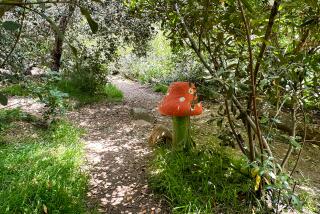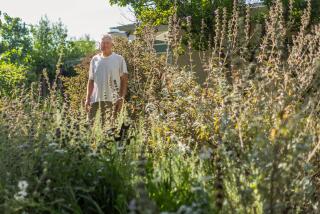A new low-tech guide to choosing native plants for your yard
If you’ve ever walked into a native plant nursery and felt defeated because — admit it — all the offerings looked like 4-inch pots of weeds, do we have the shopping/planning guide for you: a set of easy-to-carry flash cards that explain in brilliant color what those nondescript little plants will look like when they’re all grown up.
Native plants just aren’t that easy to understand for traditional gardeners, many of whom who may not realize, for instance, that a small pot of quailbush (Atriplex lentiformis ssp. breweri) can quickly grow into a 10-foot-wide, 8-foot-tall monster, great for sheltering birds and stabilizing slopes but perhaps not what you hoped for outside your bedroom window.
That’s why in 2016, staffers at the Theodore Payne Foundation for Wild Flowers & Native Plants began tossing around the idea of creating some good entry information into the world of native plants, said Executive Director Kitty Connolly.
“It was the height of the drought-lawn rebate programs, and lots of people were transforming their yards,” Connolly said. “Everybody needs to learn about natives if we’re going to have them in our future, but it’s difficult to get information to everyone at once. We wanted something that would be useful to recreational gardeners and professional landscapers, aimed more at designing and planning than maintaining.”
The foundation got a grant from the National Park Service to work with other native plant promoters in Southern California: the Tree of Life Nursery in San Juan Capistrano, Rancho Santa Ana Botanic Garden in Claremont and the Santa Barbara Botanic Garden in Santa Barbara.
The grant provided a facilitator, Patrick Johnston, “who was the soul of patience,” said Lili Singer, director of special projects at Theodore Payne. “Getting everybody to agree on a list of plants was a game-stopper for me, but he helped us step by step through the process. We hoped it would take 18 months, but from the time of our first conference call to the time the finished cards arrived, it took three years.”
Ultimately the group decided to create a series of flash cards “about the size and shape of an iPhone 6,” said Mike Evans, founder of the Tree of Life Nursery. “They’re like a deck of cards with a hole punched in the corner, and a ring to hold them together, but you can take them apart and spread them out on a table to see what plants go with other plants. They don’t replace a website or great books on the shelf; they’re just easier to carry around and use for planning.”
Singer wrote most of the text, with editing and contributions by Evans. And Carlos Flores, a Theodore Payne volunteer and National Park Service employee, created the design and made all the translations into Spanish.
The organizers “had quite a lively discussion about whether the text should also be in Spanish,” Connolly said. “There was pushback from people who wanted more info about each plant in English, but the landscape industry in Southern California is largely staffed with people who speak Spanish. We wanted to create a way for everyone to be able to talk about these native plants.”
This way, she said, the cards provide a bridge for Spanish-speaking gardeners and their English-speaking clients to more easily discuss the kinds of native plants they want to add to the yard.
And while the cards are relatively small, they pack a lot of information. You can tell at a glance how tall and wide a particular plant will grow, when it blooms, how quickly it grows, what birds and animals it attracts and how much water and sun it needs to thrive.
The cards aren’t a definitive list of Southern California native plants. They don’t include milkweed, for instance. But the decision was to create an entry-level guide that features some of the showiest plants in the native palette. “Milkweed is a very important habitat plant but it’s not much of a looker,” Connolly said. “We were going for the ones with the highest aesthetic appeal.”
The cards were designed to stay affordable, Connolly said, with a suggested retail price of $17. They are available online through the Theodore Payne website and in the stores at Tree of Life Nursery, Rancho Santa Ana Botanic Garden and Santa Barbara Botanic Garden.
And finally, Connolly says, the cards are part of a stealth plan to make native plants available at all Southern California nurseries. If people have the cards, they can more easily request the plants they want.
“If there’s no demand, local nurseries won’t stock the natives, but they will respond to demand,” she said. “That’s one of my secret uses for the cards. Yes, we want to support professional landscapers and home gardeners, but we also want retail nurseries to carry more natives.”
More to Read
Sign up for The Wild
We’ll help you find the best places to hike, bike and run, as well as the perfect silent spots for meditation and yoga.
You may occasionally receive promotional content from the Los Angeles Times.











